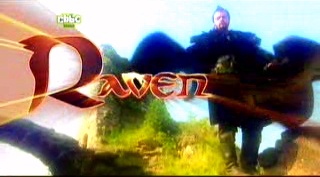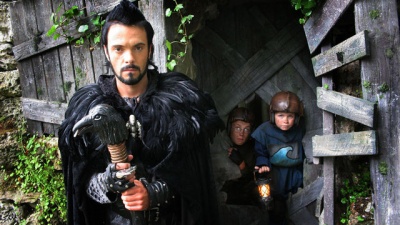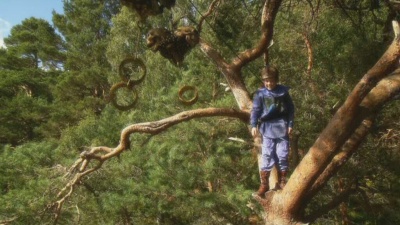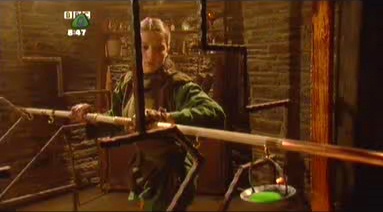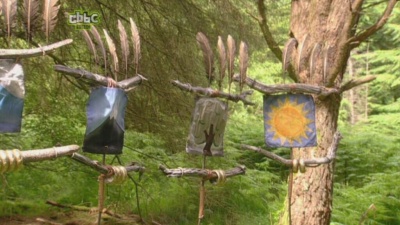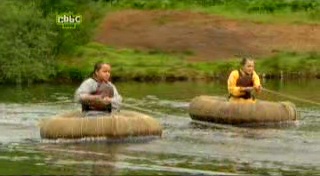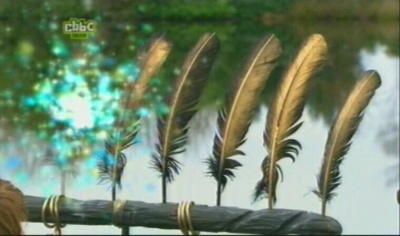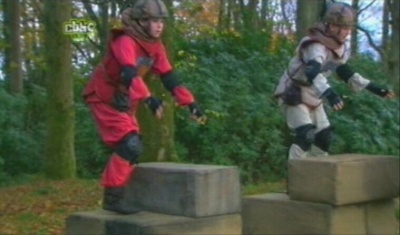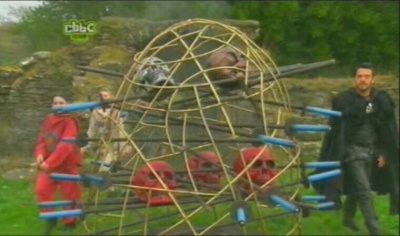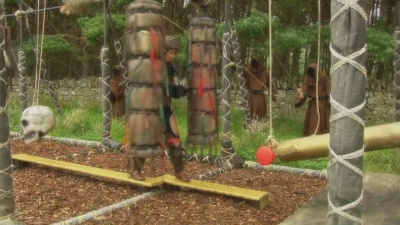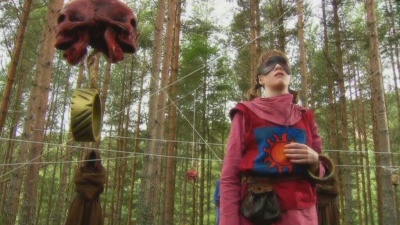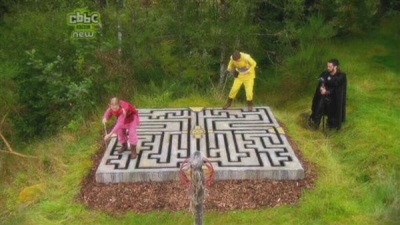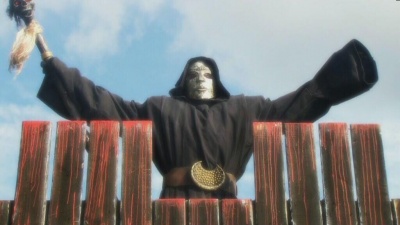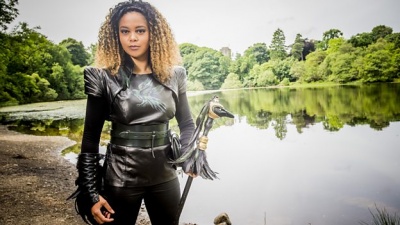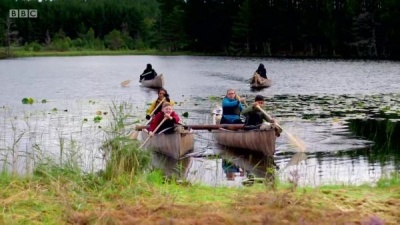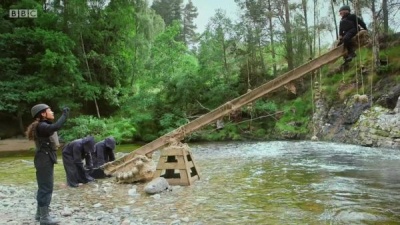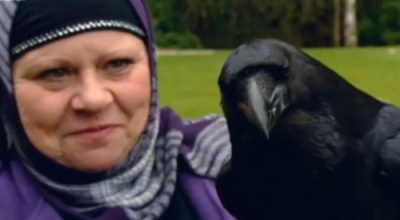Raven
Host
James Mackenzie as Raven (2002-10)
Aisha Toussaint as Raven (2017-18)
Lindsay MacKenzie as Princess Erina (Raven: The Island)
Jo James as Harrid (Raven: The Island)
Co-hosts
Gayanne Potter (Voice of The Riddle Book)
Gareth Thomas (Voice of The Wisdom Tree)
Michael MacKenzie (Cyrus the Astronomer, Raven: The Island)
Tara Sharma (Raven: The Secret Temple)
Nageswara Rao (Nevar, Raven: The Secret Temple)
Daniel Jackson (Ervan, Raven: The Dragon's Eye)
James Mackenzie ("Raven Of Old", series 11-12)
Alasdair MacIllinnein (narrator, Fitheach)
Nevar (uncredited in Raven)
Broadcast
BBC Scotland for CBBC, 16 December 2002 to 22 February 2008 (140 episodes in 7 series)
BBC Scotland for BBC One, 30 September 2008 to 19 November 2009 (40 episodes in 2 series)
BBC Scotland for CBBC, 5 January to 11 March 2010 (20 episodes in 1 series)
as Raven: The Island, BBC Scotland for CBBC, 7 August to 1 September 2006 (20 episodes in 1 series)
as Raven: The Secret Temple, BBC Scotland for CBBC, 6 to 31 August 2007 (20 episodes in 1 series)
as Raven: The Dragon's Eye, BBC Scotland for CBBC, 2 to 27 March 2009 (20 episodes in 1 series)
Children's Scotland for CBBC, 4 December 2017 to 22 June 2018 (30 episodes in 2 series)
as Fitheach, Children's Scotland for BBC Alba, 21 to 28 March 2018 (6 episodes in 1 series)
Synopsis
From very humble beginnings, Raven has grown into one of the longest-running game shows on children's television - indeed, one of the longest-running game shows on British television full stop.
In its original incarnation, eighteen contestants gather to compete in Raven's tournament, split into three qualifying groups of six. They face perils, they face challenges, they garner rich rewards. Each week of the qualifying heats sees the six face various tests - of skill, strength, courage, intelligence, and guile - to see if they had what it took to survive as warriors, and eventually to find the Ultimate Warrior of that series. Failure in any challenge costs the contestants a life. Success is rewarded with gold rings; enough gold rings can be exchanged to win back a life. Warriors leave the quest through the week, mostly via the programme's signature Way of the Warrior game.
Raven is primarily set out of doors, with everything used appearing to be carved out of nature, though with little additions like safety ropes and flotation devices. The contestants dress in mediaeval garb, are given made-up names, and there is a charming mystical air to the whole show. James Mackenzie, who plays Raven, is perfectly credible as a benevolent tutor, able to both praise and chide with a mere look, and with a very dry humour that hits the spot with parents. Raven owes much of its success to the way that viewers could identify with the contestants, and perhaps aspire to enter the contest themselves.
Opposing the warriors, leading the demons, and generally getting in the way is the show's mythical adversary, Nevar. This character was introduced in the second series as "The Guardian of the Portal", an adversary to be beaten in the week's final challenge. This demon was destined for bigger things; by series four, he was "The Enemy of All that is Good", and by spin-off series Raven: The Island, he was able to take over an entire island and summon demons by the thousand. Nevar's character was further developed in Raven: The Secret Temple, where he and Raven tangled, bringing down the temple. This was no Reichenbach Falls; both survived to fight another series.
Though there has clearly been more money thrown at it over the years, Raven has never had a huge budget, but it more than makes up for that in inventiveness and ingenuity. The games compare well with those on previous Childrens' Department productions such as Incredible Games and Sub Zero, and a few would not have been out of place on The Crystal Maze; later years almost turned into an outdoors version of Gladiators.
Raven has gathered many fans, including the BBC's Director-General Mark Byford. In a speech in 2008, he cited Raven alongside Dragons' Den as examples of how one programme can transform the reputation of a broadcasting centre - in this case, the Scottish Children's department.
The First Tournament
First broadcast 16 December 2002 - 10 January 2003. Contestants began with seven lives, gold rings were collected only to break ties. Games on the final day were played to win back lives. For this Tournament, the Raven's Eye was a brass disk on a wooden backing.
- Hunt for the Standard In which the new contestants follow subtle markings to find their standard.
- The Eyeless Demons In pairs, the warriors race down the course, hoping to unhook a ring from its pole. Barring their way are Eyeless Demons, who will hear them from the bells on the end of their hooks. This challenge was also played in the Second and Fourth Tournaments.
- The Old Troll Posed a riddle, the contestants submitted their answers on slate and chalk.
- Treasure Ring In which our contestants race off, one at a time, in small coracles. The object is to haul oneself to the middle of the course, and claim the gold ring. Winner of the race stays on, winner of the final race keeps a life; an occasional variant sees each warrior race just once, the three winners keeping lives. A fairly basic test of strength and technique, played in each Tournament except the Fifth and Tenth.
- Deep Loch Swim across a deep, cold lake. First three to the other side win rings, anyone who needs help loses a life. Played each year.
- Vale of Dunan The Riddle Book gives a clue to a word, the contestant must step on stones to spell out that word. Became Riddle Bridge from the Second Tournament, and Riddle Path from the Eighth.
- Leap Of Faith In turn, jump off a high platform and grab some rings. Openly tests courage. Played in each Tournament.
- Stepping Stones Either a solo or a two-person race along wobbly stones. Best not to fall in. Rarely played after the First Tournament. A variant was played in the Fifth and Sixth Tournaments, inviting contestants to cross a river, and Pool Plunge had the warriors jumping off a plank of wood from the Eighth.
- Spider's Cave Tied together in pairs, contestants go through a series of spider's webs to collect pairs of gold rings. Take too long, and the rings and a life is lost. Tests teamwork as much as physical prowess, and played in each tournament until the Seventh.
- Forest Of Chains The remaining warriors have become trapped in a forest containing chains. They must reach out for keys to unhook themselves.
- The High Walk Walk along a small wooden path, high in the trees, collecting rings as you go. Played in the Second and Third Tournaments, replaced by High Rope in the Fifth and Sixth, then returned in the Seventh.
- Burning Mountain Pull up a sled containing a three-dimensional jigsaw that will make a statue or shield. First to erect their statue wins. In the First Tournament, this was played as two games - pulling the sled and erecting the statue. Played every year until the Sixth Tournament; known as Blasted Mountain from the Second Tournament.
- Raven's Shield A game involving teams of three tilting a maze to get a ball in a hole was played once, during the final week.
- Mystic Pools Qualification from the weekly final was by a simple riddle, attempted first by the warrior who led on lives. The grand prize was also awarded by a riddle.
- The Way Of The Warrior A fearsome set of traps aim to knock the warrior from the true path - swinging bodies, falling rocks, a clothes dryer spinning with heavy leather balls, a falling anvil, a narrow section, moving shields, a swinging contraption that requires the brave to crawl underneath, and swinging blades bar the way. Success grants a rich reward - progression to the next stage of the quest. Played daily, this is Raven's signature game. It has been modified between each Tournament.
The Second Tournament
First broadcast 8 December 2003 - 2 January 2004. Warriors again began with seven lives, but could exchange seven rings for a new life. Failure in any challenge resulted in the loss of a life. Raven's Eye was now part of the carving atop the staff carried by Raven. This tournament also brought in colours for each player, and used the logos on the warrior's standard to greater effect.
In addition to some games from the first tournament, the warriors faced following new challenges:
- Fire Demon In which the warriors are blindfolded, and wave about a big white stick with knobbly bits, hoping to hit a water-filled balloon controlled by wires before the balloon hits them. Thanks to some CGI trickery, the balloon is transformed into a blazing fireball. Also played in the Sixth Tournament.
- Ring Climb Climb up a ladder of rings and beat your opponent to the top. A simple test of strength and technique. Also played in the Third Tournament, as Treetop Treasure in the Ninth, and Ladder Ascent in the Tenth.
- Dragons' Blood Collect four saucers of dragons' blood, and put them in a chest to gain a gold ring. Spill a drop, and a life is lost. This is a clever game, as the saucers have to be picked up on a horizontal pole, and that pole has to gently traverse an up-and-down maze. Played occasionally until the Fifth Tournament.
- High Tower Contestants stand about ten feet in the air, on towers of enlarged brown sugar cubes, and bat each other about with oversized cotton wool sticks. The towers are stuck together, but are unstable, and the first person to fall off, or topple their tower, loses. Often, a vigorous approach will be someone's (literal) downfall. The idea wouldn't have been out of place on Gladiators - for the Seventh Tournament, this moved onto wooden poles, an almost carbon copy of Duel. Another of those winner stays on games, with only the ultimate winner retaining a life. Variants have the contestants swinging a ball between them, sitting astride a beam, standing on a draught excluder, or playing on stones floating in the water. Something along these lines has been played most weeks.
- Demon Square A bush voiced by Gareth Thomas asks true-or-false questions in rhyming couplets: contestants must get five answers right to claim a ring; two errors will cost a life. Shades of general knowledge, but with everyone playing, the effect is sometimes more Runaround than Fifteen-to-One.
- Burning Battlements Effectively, a solo skill test - shooting a catapult at those water-filled balloons against the clock. Again, CGI turns the balloons into fires, and this time the effect is more credible. CGI appears to work best in two dimensions. Played again in the Third and Fifth Tournaments.
- Thrall Demons The leader is blindfolded and someone else calls out to guide them round a course containing rings and threads. Touch a thread, the bell will ring, and the demon will get you. Tests communication skills. The game featured in each Tournament until the Sixth. Variants have been played - Raven called the moves on the final day of the First Tournament, and Thrall Forest set the action outdoors in the Eighth and Ninth.
- The Dark Path Blindfolded, the contestants must follow a trail of vines and avoid false leads and beat their opponent to the finish. Probably the most atmospheric game of the week, testing touch and thought. Played in the Third and Fourth Tournament.
- Dragon's Lair Climb up a rope ladder faster than your opponent, collecting rings en route, to retain a life. Came back in the Third Tournament.
- The Last Stand Nevar sits atop a portal. He has scattered pieces of a key to open the portal around the field, and there are a lot of wooden walls around. Yes, this is paintball, only without the paint, and with only one person being able to shoot. The player who can gather the pieces of their key and turn it first will win, go through the portal, and come back in finals week. This replaced the Dark Pools from the previous year, and came back without change in the Third Tournament.
The Third Tournament
First broadcast 22 November - 17 December 2004. There were no changes to the rules, and only slight changes to the presentation. The emphasis early in the week became team games.
- Millstone Tower, in which three warriors work as a team to move three large millstones through some slalom gates, on which dragon's eggs are placed. Disturbing the eggs incurs a time penalty in the race game. Returned in the Fourth and Fifth Tournaments.
- Water Demon, in which two warriors on shore work to pull one of their number back before they're caught by a demon. Returned in each tournament until the Sixth, and again in the Eighth.
- Troll Trap, where rings must be retrieved without touching the floor, by using a pole through the sides of the cage, and within a time limit. A very well-executed game, which hasn't come back.
- Enchanted Stream and Goldrush. The warriors are to build a bridge over a river, or to allow gold to flow down into a crucible and forge a ring. In each case, the fundamental task is to lay out five pieces in the correct order, and the right way round, to complete the path. A very satisfactory visual effect in Goldrush sees the pieces of the puzzle give off little sparks when they first touch the playing floor. Enchanted Stream was also played in the following tournament.
- Serpent's Eye, an archery challenge. Each warrior has three arrows to hit the target at all to avoid losing a life. Hit the serpent's eye in the middle to win a gold ring. This game returned until the Sixth Tournament, and as Warrior's Eye from the Eighth.
- Rune Rock, where the warriors are challenged to complete a three-dimensional jigsaw displaying a particular pattern. We had a suspicion that one of the jigsaws was easier than the other.
The Fourth Tournament
First broadcast 21 November - 16 December 2005. Warriors now began the tournament with nine lives, with nine rings required for a new life. The designs on the standard were re-drawn in bolder colours, and now animated on screen. In an attempt to build a back-story into the programme, Nevar, the guardian of the portal, was seen on screen without his mask.
- Snake Pit, where teams of three take a wooden box each, and cross a pit by moving the boxes from the back to the front of the line. The same game mechanic was used in Spiders' Wood in the Sixth Tournament.
- Pole Climb, which is Poleaxe from Gladiators, but using telegraph poles rather than plastic poles, and with the added distraction of rings between the warriors for either to grab. This returned in the next tournament, and as Tree Climb in the Tenth.
- Dwarf Mine, where the two leaders go into a mine. One has to describe complex hieroglyphics to the other, in the hope of gaining rings. Played in each Tournament until it turned into The Gorge for the Seventh Tournament, where there was an added pressure of a demon chasing the warriors along a stream and up a waterfall.
- Tower Build. Warriors are paired off, and build a tower out of cuboid boxes. The first pair to reach the rings placed within everyone's reach wins. The game returned until the Seventh Tournament.
- Demon Causeway, a game that rather reminds of the Dark Knight from Incredible Games, or the Vortex from The Adventure Game. Alternately, warriors and demons move around a 6x6 grid, the warriors are trying to avoid bumping into the demons. Gold rings are scattered liberally around the grid. This clearly worked well on paper, but not in practice - the demons played a perfect game each time, the warriors didn't, and the result was tedious for its predictability. A different game with the same name appeared in the Tenth Tournament.
- The Last Stand was changed into a physical challenge, passing through various obstacles, under a net, over some hurdles, and up a slope with water running down. The time advantage for the leader was slim, and seemed to vary from week to week. Though the course had added difficulties from the Fifth Tournament, and was entirely remodelled for the Eighth, it remains primarily a physical challenge.
The Fifth Tournament
First broadcast 20 November - 15 December 2006, with minimal changes to play and presentation.
- Warrior's Gate, the first game of each week, asked contestants to construct a winch so that they might fly their standard and earn their warrior symbol. A simple challenge, but enabled the show's dramatic story to be constructed more easily. Also played in the Sixth Tournament.
- Torture Chamber Two warriors use claws and a basket to retrieve rings and a key to get out. Also played in the Sixth.
- Battering Ram Use a number of logs to roll a heavy battering ram to a door, and break through it. Played in teams of three, and returned until the Seventh.
- Nevar's Eye Blindfolded, warriors must use sticks to tap out a safe path without bumping into the ubiquitous demons. Returned in the Sixth Tournament.
- Battle of the Boats Use a canoe to paddle from one side of a river to the other. This name was used for a team game in the Seventh Tournament, where teams of three raced to collect rings and avoid the floating demons; and again for "Raft Race" in the Ninth.
- High Rope Cross a rope suspended between two trees, with the option to collect rings en route. A replacement for High Walk, but much more challenging. Played again in the Sixth Tournament, and (as Ring Reach) over a fast-flowing stream from the Eighth.
The Sixth Tournament
First broadcast 5 - 30 March 2007, and filmed at around the same time as the Fifth Tournament. All the challenges from the last series were present, along with four new ones.
- Spiders' Wood, a variant of Snake Pit, with teams of three using planks to cross a mesh of spiders' webs, without touching the webbing. A timed game, rather than a race.
- Deadman's Vault, where warriors use long strips of metal to guide a ball from the top of a maze to the bottom. The effect is similar to a game played on The Crystal Maze.
- Ring Rack. A tug-of-war challenge, with success represented by the motion of a lever between the seated warriors. Played in the subsequent Tournaments.
- Zip Line, where each contestant is securely tied to a rope slide, and uses poles to hook rings.
The Seventh Tournament
First broadcast 28 January - 22 February 2008. With the exception of a new map, the first since the Third Tournament, there were no changes to the presentation. The final day of each week of the heats had four new games set beneath Blasted Mountain, and a warrior was eliminated on each day of the final week, leaving just two to play the last day. There were many changes to the games - old ones returned, often under slightly different names, and a long list of new challenges:
- Warrior's Race saw the contenders canoe to shore and claim their emblems. This has been played in each tournament since.
- Skull Cage was a life-sized version of Kerplunk. The week's pace-setters removed rods from a large cage, trying to get their target skulls down to the floor without dislodging the red skulls. Played again in the Eighth.
- Demon Army. A three-player game involving the use of an oversized elastic band to lob polystyrene rocks at an advancing cohort of demons. Hit all of them before they reach the ring pole to claim what's on it. This one has also returned each tournament since.
- Cliff Face had the contestants climb up a cliff, collecting all three gold rings. A demon set off once they'd collected the first ring; the warrior had to collect the other two rings before the demon could touch them.
- Target Run had the warriors firing a crossbow at a large moving target.
- Fire Water used a catapult to shoot rocks at a target some distance away on the loch. Hitting the ring resulted in a very satisfying pyrotechnic display.
- Wrestling Ring. Wrestling on the water.
- The Chasm was the first game set beneath Blasted Mountain. Warriors traversed a narrow beam, avoiding the swinging rocks, and collecting gold rings. A very difficult game.
- Boulder Run invited the warriors to push a boulder along a narrow passageway, collecting gold rings as they go, while being pursued by a demon.
- Lava Pit had the warriors gather skulls by hooking them from a platform in the middle of a lake. First player to collect ten skulls can escape and claim rings.
- Stone Soldiers was the final game played beneath Blasted Mountain. To destroy demons blocking the exit, warriors had to complete a 3-D jigsaw and form a likeness of a soldier. This was played outdoors in the Eighth and Tenth tournaments.
- Stone Bridge used the floating platforms from Stepping Stones and a plank of wood to step from one stone to the next. First to the central ring claims it.
The Eighth Tournament
First broadcast 30 September - 4 December 2008. This series had some major production changes: filming moved to locations around Aviemore, and the series was shot in high-definition. There were presentational changes: the feathers removed from warrior's staffs were only shown as computer-generated mocks, and the staffs themselves only appeared at the beginning and end of each show. The transit shots of Raven leading the warriors to their next challenge were also removed, replaced by Raven discussing tactics with some of the warriors. This series was the first to premiere on BBC One, and aired at the rate of two episodes per week. The series had a nominal running time of 30 minutes, with episodes lasting about 28 minutes, somewhat longer than previous years.
- Puzzle Stack in which the warriors drag blocks on a rope from the loch, and assemble them into a set of steps. First team to grab the rings keeps them. A bit like Millstone Towers, really.
- Dead Man's Gorge - one at a time, the warriors leap into a river, hoping to grab a ring as they go. They'll then float down, grabbing more rings as they travel. Failure to take any of the rings costs a life. This was back in the Ninth and Tenth.
- Raft Race was another team game, this time getting the competitors to put logs into a frame and assemble a raft, which they paddle to a stack of rings in the loch. A loud game, the logical follow-up to Battering Ram, and played in the next series under the title of Battle of the Boats.
- Raven's Rock saw two selected warriors abseil down a rock face, grabbing rings as they go. Only the first to the bottom keeps a life. This was always played between the last two warriors in the standings, determining which would be the first to face The Way of the Warrior. It was used for this purpose in the next two series.
- Ravine. A two-player communication game: one is on top of a rocky outcrop with some boxes, the other is in a river, trying to find the right keys to open the boxes. Another game that came back in the Ninth and Tenth as Sunken Treasure.
- Demon Rock asked warriors to pass along a rocky outcrop, past a demon, and leap for rings hanging from a tree's branches. Touch the demon, they've lost. Fall in the water, they've lost. Fail to get any rings when they jump, they've lost. This one returned in the next tournaments.
- Demon Star was another two-player game. One person is in the courtyard of a ruined castle, where demons vanish and symbols are revealed. Their colleague uses long blocks to spell out that word.
- Target Mines - use a crossbow to explode mines. A simple game, played each tournament since.
- The Drop. Descend a sheer rock face, then cross a river on a zip line.
- Demon River had a task to cross tightropes slung across a river before the demon passes underneath.
- Key Descent was a two-player game. The pair descend a sheer cliff, with boxes containing gold rings. These boxes require a key to be passed, and both players must touch the ground before a skull is wound down.
- Pool Plunge reminded us of Stepping Stones from the first series, only with warriors edging along a narrow wooden plank to dive into a ring. It came back in the Ninth and Tenth.
- Skull Rings, a variant on Thrall Forest, with the leading warrior blindfolded and asked to bash skulls to pick up their gold rings, while directed by the next contender.
- Ring Reach was series 5 game High Rope on water.
- Ascent. Run up a hill. First to the top wins. A cunning variant, Scramble appeared in the next tournament, asking the warriors to descend the hill before climbing it.
- Skull River had the warriors paddling their canoes through a series of gates, and through a final gate to claim their rings. This was a dead ringer for Paddles Up.
The Ninth Tournament
First broadcast 15 September - 19 November 2009, still on location around Aviemore, and with no other presentational changes.
- Pendulum was a team game, with warriors on opposite sides of a river helping a colleague cross and collect rings as they went. This came back in the next series.
- Forest of Fear put three warriors up trees, with rope linking them to a hook allowing them to pluck gold rings from lower platforms. A very similar challenge had been played on Jungle Run.
- Pontoon Pursuit had pairs of warriors chasing each other around a floating square, hoping to catch the other before they fell in. Another game that was played in the Tenth.
- The Bridge was an abseiling race: one member of a pair let themselves down vertically, the other controlled their horizontal movement from the ground.
- Roman Road, a difficult arithmetic challenge using Roman numerals. A simpler version using coloured spots had been played on The Dragon's Eye. This returned in the Tenth.
- Conundrum was another game for pairs, where one would make a simple jigsaw and describe its contents to their team-mate, who would use it to locate a ring. Again, back in the next series.
The Tenth Tournament
First broadcast 5 January - 11 March 2010.
- Teathered Maze A key is on the end of a chain. On the other end is a skull, and that's trapped beneath a maze on the floor. In pairs, warriors must race to guide their chain along the path to the exit.
- Demon Causeway (2) Teams of three use planks to get from one end of a pit to the other, using sticks to pick up rings as they go. Similar to various games from the spin-off series.
- Golden Stairway A very difficult game: warriors ascend a number of golden steps to a platform over the water, where they must jump and collect a ring.
- Sunken Symbols Played in pairs, warriors have a limited time to swim around a lake, opening boxes according to a sequence of clues concealed beneath rafts.
- Skull Assault Broadly similar to Demon River, as the weekly finalists were to cross a tightrope, open a cage, and move down a zip line, all before a demon reached them.
- Puzzle Pool Played in the final week, this involved manipulating three balls through a giant shield in the water. This wasn't dissimilar to "Raven's Shield" from the very first finals week.
Raven: The Island
A spin-off series was broadcast 7 August - 1 September 2006. Rather than find a single champion, the aim was to defeat Nevar and drive him from the island of Alaunus. Three teams, initially of four warriors, split up and spent fifteen episodes scouring the island for timepieces that would be of use in the final week. Any warrior who failed to complete the assigned task correctly would be entirely eliminated from the quest. The final week was an assault on Nevar's fortress, with the aim of taking one acorn from the Enchanted Oak that would ensure Nevar could be deposed.
Raven: The Secret Temple
Filmed at Ramoji Film City near Hyderabad, this series featured twelve British and four Indian children, with Bollywood star Tara Sharma in the role of Princess Satyarani. The series aired 6 - 31 August 2007, as part of a BBC India season. The excuse for this excursion was that Nevar had put Raven's land under a curse of Perpetual Cold, and he had taken sixteen of his finest warriors to a land far to the east to gather an Elixir that will break the spell. The warriors were split into four teams of four, and faced three weeks of challenges to prove their worth to enter the temple. Warriors who failed a challenge in this phase could be bought back at a cost to their team, but only the once. The final week's adventure in the temple consisted of individual battles for each warrior, with luck playing a factor in who stayed and left. A hand-to-hand battle between Raven and Nevar provided a long dramatic diversion.
Raven: The Dragon's Eye
A return to Scotland for this third spin-off series. The backstory was that Nevar had become aware of a stone (called The Dragon's Eye) that would corrupt anyone it touched. Raven wanted his warriors to beat Nevar to the stone, so that he could destroy it. An added complication was Ervan, a humble woodsman who may or may not have been siding with Nevar. The game mechanic was very similar to The Secret Temple, with four teams of four reduced to six people for the final week, and quite deliberately finding one winner at the end of the series. This series aired 2 - 27 March 2009.
After ten main series, three spin-off tournaments, and something like five solid days of television, Raven quietly came to a conclusion in March 2010. That year's Mission 2110 was made by many of the same production crew, and had a very similar feel.
Nevar Say Nevar Again
All sorts of classic game shows were revived in the late 2010s. Raven wasn't to be left out, and a new series was commissioned for 2017.
Aisha Toussaint took over as the new Raven, though James Mackenzie was given a role as "Raven Of Old". The excuse for this was that the spell Raven Of Old had cast to expel Nevar had reflected back, sending the pair of them to a desolate land.
The old distinction between lives and rings has been abolished: treasure rings are the only currency of the new series. Groups of four warriors compete under an animal banner (Bear, Wolf, Wildcat, Stag). The lowest-placed warrior leaves after the second day, and long-term fans regretted that this departure was without ceremony - the Way of the Warrior did not feature. The group's champion emerges after three days. Only the champion progresses to the final tournament.
Advances in technology and changes in style made the new Raven a show of its era. "Bullet time" had been used since The Cube a decade earlier, now hyper-slow-motion replays were commonplace to be used on a children's show. A new music package kept to the fashions of other fantasy shows.
About half the games returned from previous series without major changes. Over the series, we saw Pool Plunge, Dead Man's Gorge, Conundrum, Demon Causeway (2), Leap of Faith, Raven's Rock, Scramble (also called Warriors' Race), Treetop Treasure (and the similar Spider's Web). For the heats, The Last Stand was almost identical to its format from the Seventh Tournament.
Now played by the team: Demon Army, Battering Ram, Target Mines - all would win or lose rings. Stone Soldiers remained a race game between two warriors. Vale of Dunan was renamed Riddle Rocks, and all warriors would take part - there were no games reserved for the leader.
Archery game Warrior's Eye now required a very sharp shot to win. Demon Path was a retitled Demon Square, with Raven Of Old voicing the questions in place of the Wisdom Tree, whose actor, Gareth Thomas, had died in 2016. Towering Heights was Tower Build played against the clock rather than as a race.
The new games were:
- Deep Loch (2) - new warriors arrive in two joined canoes, and race demons to shore.
- Cursed Chasm - a race across a river, dangling from ropes and harnesses, collecting rings as you go.
- Loom Labyrinth - follow threads through a loom, and pull the lever to release rings, not skulls. Played solo and by pairs of warriors.
- Magnetic Maze - one warrior is beneath a table and moves a magnet, while the other is above the table and directs them. Two teams play at once.
- Warriors' Wall - pairs of warriors have a limited time to build a wall to defend a stone statue against a wrecking ball.
- Escape the Cage - a warrior needs to free themself before being crushed in a cage. Their companion can see the codes to open locks, and communicates the answers.
- Forest of Golden Orbs - another archery challenge, striking balloons in a wood. Played at dusk, so the balloons light up.
- Elixir of Life - a practical demonstration of a classic riddle.
- Symbol Search - a wordsearch, with each letter replaced by a symbol. Played by pairs of warriors, only one can see the letter-to-symbol key.
- Idol Wise - pair up the symbols beneath idols, to reveal four that have no pair. Very difficult.
- Warriors' Seat - one warrior is blindfolded in a seat that swings across a river. Their companion guides the seat, and tells the warrior how to collect rings and not touch skulls or fall in the water.
- Orb Race - Running through a field in coloured orbs. Fun for all warriors.
- River Slalom - Kayak through a quiet section of river, to reach the many rings on offer before time runs out.
- Stone of Destiny - Line up five staffs, so the prism on the end of each is at the same height. Staffs and holes all have different lengths.
- The Last Stand (Final) - a spectacular finale, the challenge is to collect eight tokens from around a large course, and slot them in place. A mixture of the finals of Fun House and Total Wipeout final, with the free-form closing stages of Scavengers.
The same format and games were used in a second series, broadcast in June 2018.
A Gàidhlig
Fitheach, a Gaelic-language version, featured three warriors competing six challenges before The Last Stand from the final.
Raven greeted the warriors and briefly explained the challenge in Gaelic. Just as James MacKenzie narrated many of the games in the English-language version, Alasdair MacIllinnein narrated throughout Fitheach.
Catchphrases
"Let the challenge -- begin!"
"You must be quicker, young warrior."
"May the luck of the Raven's Eye be with you."
"You leave with honour."
"Be quick, my young friends, the sands are falling fast"
Trivia
The programme is filmed on location at the following sites:
- Castle Toward in Dunoon (series 1-7)
- Auchengillan Outdoor Centre (Raven: The Island)
- Mugdock Castle, Mugdock Country Park (Raven: The Island, Nevar's Fortress scenes)
- Ramoji Film City, India (Raven: The Secret Temple)
- Lagganlia Centre near Aviemore (from series 8 and Raven: The Dragon's Eye)
- Ruthven Barracks, Alvie Estate, and the RSPB Tromie Bridge Reserve (series 8)
- Balvenie Castle, Dufftown (Raven: The Dragon's Eye, castle scenes)
- Ardverikie Estate; Glenfeshie Estate; Glenmore Forest Park; Highland Folk Museum, Newtonmore; Inshriach Forest Park; Loch Park Adventure Centre, Drummuir; Seafield Estate, Carrbridge (Raven: The Dragon's Eye)
Michael is the father of James, but they are no direct relation to Lindsay.
Raven won the Children's BAFTA for Best Entertainment Series in 2003 and 2006, for the previous year's shows.
Of course James Mackenzie only plays Raven in his human form. In his corvid form, Raven is played by a raven (natch) named Jake.
Web links
BBC programme page (BBC Alba version)
See also
Weaver's Week reviews: Series 1 | Series 2 | Series 3 | Series 4 | Series 5 | Series 6 | Series 7 | Series 8 | Series 9 | Series 10 | The Island | The Secret Temple | The Dragon's Eye | 2017 revival

